The Big Little SF Magazines of the 1970s
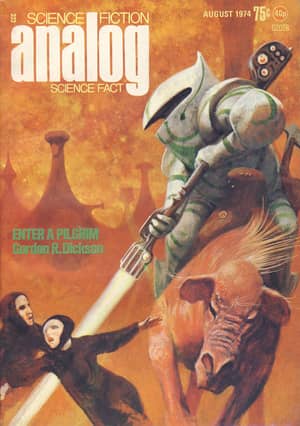 An earlier version of this article was published in Black Gate 10.
An earlier version of this article was published in Black Gate 10.
These columns are focused on the history of SF – and so far that has turned out to mean mostly discussion of 50s oriented subjects, with some leakage into nearer years. But now I’d like to take a look at a rather more recent, and rather less celebrated, period. The 1970s. The time of wide ties, leisure suits, and disco. And also the time I discovered SF, and the SF magazines.
My first look at real SF magazines is a moment I remember with a continued thrill. Sometime in late July 1974, in Alton Drugs in Naperville, IL, I wandered by the newsstand and my eyes lit on three magical covers: the August 1974 issues of Analog, Galaxy, and F&SF. That day I bought Analog. The cover story was “Enter a Pilgrim” by Gordon R. Dickson, with a striking, odd, John Schoenherr painting, featuring an alien with a lance and ceramic-appearing armor (a sort of Schoenherr trademark, that ceramic-like surface).
I read that issue quickly and the next day I bought Galaxy, which featured “The Day Before the Revolution,” an Ursula K. Le Guin story that would win a Hugo, as well as parts of two different serials – The Company of Glory by Edgar Pangborn and Orbitsville by Bob Shaw. Of course that issue was also read before the day was out, and the next day I bought F&SF – a very important issue in its own way: it featured John Varley’s first published story (or perhaps his co-first story, as we will see later.) It wasn’t long before I had added Amazing and Fantastic to the roster. Soon I was subscribing to several magazines, and buying the others each month at the newsstand.
Those five were all the major, well-distributed, magazines there were by 1975. Alas, I just missed seeing If, Galaxy’s long time companion: it was discontinued at the end of 1974, and for some reason my local newsstand didn’t carry it, at least not those last few months.
I had formed an opinion, based on received conventional wisdom, that the “Big Three” of SF magazines had been Astounding/Analog, F&SF, and Galaxy since 1950: certainly that was the case in 1975. (You will get an argument for many years prior to that, however: there are partisans for Startling Stories in the early 50s, for If at various times, especially during Frederik Pohl’s peak editorial period in the mid-60s, and for Amazing and Fantastic under Cele Goldsmith’s editorial hand in the early 60s.)
Galaxy, however, was in some financial trouble. Under Jim Baen’s editorship it enjoyed a couple of years as a truly wonderfully enjoyable magazine, but when he left the decline was swift. However, Galaxy’s place in the “Big Three” was quickly taken by Isaac Asimov’s Science Fiction Magazine. And throughout the 70s, the sister magazines Amazing and Fantastic, edited by Ted White, were the other major prozines.
[Click the images for galaxy-sized versions.]
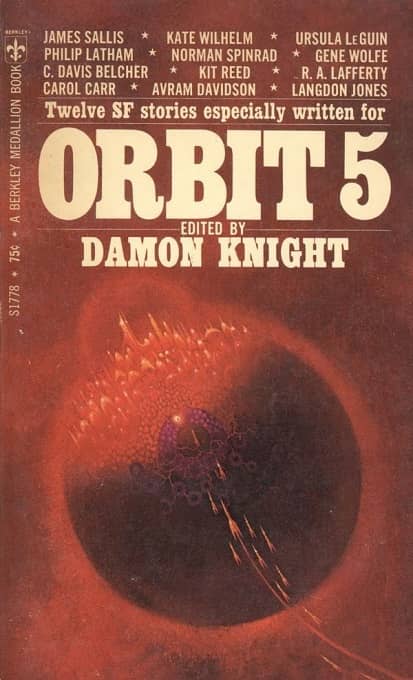 |
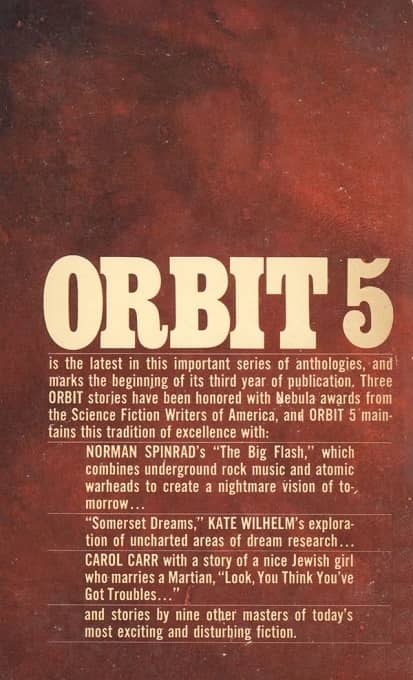 |
Most of the rest of the prominent short SF of the 70s appeared in original anthologies. The 70s were a boom time for them. For most of the decade there were three major series: Orbit, Universe, and New Dimensions, as well as a few lesser ones, Quark, Infinity, and Chrysalis among them. There were also scads of one-shot theme anthologies, many edited by Roger Elwood. I was soon buying many of these books as well.
So – five major magazines, and lots of anthologies. Was that the whole of short SF in the 70s? Indeed no! In this article I will cover a series of other magazines, most of which appeared irregularly and lasted only a short time. Some were fairly crudely produced, put together with a typewriter on inexpensive paper. But others were beautiful: many were attempts at slick SF magazines, and a couple were as professional appearing, and as nice looking, as any SF magazines have ever been.
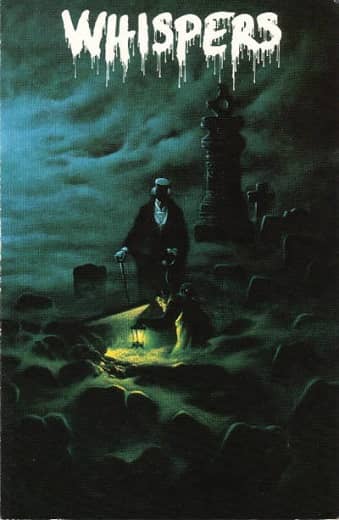 |
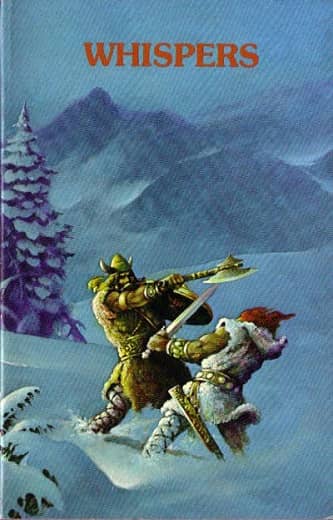 |
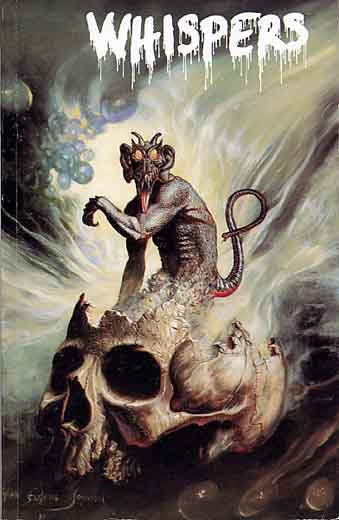 |
The Other Magazines
For the purposes of this article I’m restricting my coverage somewhat artificially to a group of magazines that all began publication in the 1970s, were all primarily science-fiction oriented, produced in the United States, and eventually appeared in a fairly professional-looking large (8½” by 11”) format. This leaves out a number of magazines of some importance. Chief among these may be Whispers, Stuart David Schiff’s outstanding horror magazine, which began life is a modestly produced digest-sized saddle-stitched ‘zine, but which eventually evolved into an elegant large size, and indeed also became an original anthology series. Another critical horror magazine was W. Paul Ganley’s Weirdbook, which began appearing in 1968 and lasted until 1997. Its last issue was actually bound with the last issue of Whispers.
Among SF/Fantasy magazines, a couple of digests were revived in the late 60s or early 70s by UPD, publishers of Galaxy. Worlds of Fantasy (1968-1971) was first edited by Lester Del Rey, then Ejler Jakobsson. It is remembered mainly for publishing Connie Willis’s first story, “Santa Titicaca,” as well as one of Michael Bishop’s first (another appeared in Galaxy at about the same time). Worlds of Tomorrow was for some time a companion of Galaxy and If, then suspended, but revived in 1970 for three issues, edited by Frederik Pohl and then Jakobsson.
Finally, I’m leaving out one truly important but somewhat anomalous magazine: Omni. It began publication in 1978, and under fiction editors Ben Bova, Robert Sheckley, and Ellen Datlow published a lot of outstanding SF. But it was really primarily a popular science magazine.
This leaves the following magazines, listed in order of first appearance:
Eternity, editor Stephen Gregg (later with Henry Vogel) (1972)
Vertex, editors Donald Pfeil and Lawrence Neal (1973)
Odyssey, editor Roger Elwood (1976)
Galileo, editor Charles Ryan (1976)
Cosmos, editor David Hartwell (1977)
Shayol, editor Pat Cadigan (1977)
Asimov’s SF Adventure Magazine, editor George Scithers (1978)
I would brand Eternity, Galileo, and Shayol as “semi-professional” magazines. They were fully professional in presentation, but they were published on small budgets, without the backing of a commercial publisher or distributor. The other magazines were all put out by fairly major publishers. In particular Asimov’s SF Adventure Magazine was a companion to Isaac Asimov’s Science Fiction Magazine, which began its life in late 1976 and quickly became one of the top magazines. However when I label a magazine “semi-professional” I am on shaky ground: the line between professional and semi-professional is surely hard to draw. For instance, of all these magazines Shayol was certainly the nicest looking: really, the most “professional” in appearance. By contrast, Vertex can’t really claim to have had significant distribution, and its last issues appeared in newspaper format.
I’ll cover them in the order above.
Eternity
This magazine had two separate incarnations. The first lasted 4 issues, one a year from 1972 through 1975, despite ambitions for more frequent publication. It was never a particularly attractive magazine, though it improved issue by issue. (I did like much of the artwork, especially that by Stephen Fabian, but the reproduction was not very good.) It was produced mostly on a typewriter.
Eternity stands as strong evidence of how much desktop publishing has improved the look of even the least expensive, least professional, magazines. It published generally fairly short stories, with a couple of short novelettes mixed in over the four years. Also, quite a lot of poetry, and plenty of features including interviews, book, movie and comic reviews, art features, cartoons, and opinion pieces.
Eternity Science Fiction #4 TOC
As a whole I found the fiction fairly weak. There were stories by fairly well-known writers: Barry Malzberg, Andrew J. Offutt, Roger Zelazny, Joseph Green, and David R. Bunch. But none were anywhere close to these writers’ best work. Perhaps more important were the new writers Gregg published who went on to do much better work. Glen Cook and Edward Bryant had early stories, while Arthur Byron Cover and Stephen Leigh each made their first appearances here.
Also of some note is Eternity’s emphasis on speculative poetry, which was highlighted by a Peter Dillingham article that served as a definition plus manifesto for SF poetry. I have to say that little of the poetry was much to my taste, though. Finally, the three interviews Eternity published were all interesting: with Thomas Disch, Damon Knight, and Kate Wilhelm.
Four years later, with the help of a new co-editor and publisher, Henry Vogel, Gregg resurrected the title. This second incarnation of Eternity was a slicker product all around. The covers were color and on much better stock, and the interior paper and presentation was also much improved. However, despite a bigger budget, better look, and presumably better distribution, it lasted only two issues, in 1979 and 1980.
Eternity Science Fiction #4 (interior)
Features included an editorial each issue, signed by both Vogel and Gregg; a review-oriented column by Andrew J. Offutt called Ozymandias; a story rating feature; a book review column by Orson Scott Card; the Locus SF Bestseller list; a “Writing SF” column, by Darrell Schweitzer in #1 and Roger Zelazny in #2; a Science column by Karl T. Pflock; a film column by Edward Bryant; and a Letter column. There is also a Speculative Fact feature by Pamela McCorduck in #1; and an interview with Gregory Benford, conducted by Schweitzer, in #2. And the emphasis on poetry was much reduced from the first series: only a couple of Peter Dillingham poems in #1. Of these I must say I found Card’s reviews the most interesting.
The fiction was better as well. For one thing, there was more than twice as much per issue. The quality was also better. Gregg did reprint four stories from the first Eternity, and not necessarily very good ones. But he published some strong new stories. Best may have been Orson Scott Card’s “Tinker,” a curious hybrid of SF and Fantasy, part of his Worthing Chronicle. I also liked John Shirley’s “Undermuck with Quill Tripstickler,” an amusing, rather Vancean, piece about a trainee for a Galactic tourist agency. Stories by Grant Carrington and the recently deceased Ronald Anthony Cross were also pretty fair.
Vertex
I remember Vertex as perhaps the first “other” magazine I ever heard of. Certainly it was the first besides the top five that I tried to subscribe to. I sent in my payment for a year’s subscription, and was shocked to receive of all things a NEWSPAPER! Which is to say, a newsprint publication, tabloid size, probably containing about the same amount of fiction as the regular issues. I believe I had a one-year sub, but I never got another issue, even though (according to Science Fiction, Fantasy, & Weird Fiction Magazine Index: 1890-2002 by Stephen T. Miller & William G. Contento) two more issues were put out. I did eventually receive a three-pack of earlier issues, all bound together — I have an idea that was because I ordered back issues, though. This was the first time I was “cheated” by an SF publication — far from the last, alas!
That issue – June 1975 – included two stories of some note: Harlan Ellison’s “In Fear of K” and John Varley’s “A Choice of Enemies.” These are of note, however, only because of the writers. I don’t remember that the stories themselves much impressed me. Varley’s story has never been collected, indicating he probably didn’t think much of it.
Vertex interviews Harlan Ellison
Vertex actually began publication in 1973. There were 16 issues total, on a reasonably close to bimonthly schedule, the last appearing in August 1975. The first 13 were quarto: that is, 8½” by 11,” saddle-stapled, and they were of a generally professional appearance, though not terribly attractive to my taste. The editors included Donald J. Pfeil and Lawrence Neal.
In layout, artwork, and color scheme Vertex simply screams “70s.” I found a copy of the August 1974 issue for this article. The cover is by Norm Walker, all browns and oranges, an ugly thing portraying four misshapen heads with lines leading to a less ugly face. I have never heard of Walker. The interiors are three colors: black, white, and orange. The artists are Roger MacGowan, Bruce Day, Stevan Arnold, Tim Kirk, George Barr, Monte Rogers, Leland Long, Susan Jenkins, and Alicia Austin. Barr, Kirk, and Austin are familiar names to me (though I’ve seen nothing from either Kirk or Austin in a long time), and I like their work. The other artists are completely unknown to me, and I didn’t like their work here at all.
There was a reasonable quantity of fiction. 13 stories in the August 1974 issue, 5 of them short-shorts, two fairly short novelettes. The best known is almost certainly Larry Niven’s “Night on Mispek Moor,” a science fiction tale of a “company war” but featuring zombies on another planet. There were also much weaker stories by Harry Harrison and Joe Haldeman, and pretty good contributions by F. M. Busby and Stephen Goldin. And in a way most significantly, a very obscure story by John Varley, “Scoreboard.” It’s not very good (and it reuses an idea used earlier by Ben Bova and Myron Lewis in “Men of Good Will”), and Varley hasn’t reprinted it either, but it turns out to be tied with the much better, and better-known, “Picnic on Nearside,” as his first published story – both appeared in August 1974.
Vertex #5 Table of Contents (December 1973)
A look through the TOCs of other issues of Vertex reveals some mildly prominent names: Jerry Pournelle, Terry Carr, Edward Bryant, George Alec Effinger, a few more, but few memorable stories. The best were probably a couple by Niven: “The Alibi Machine” and “All the Bridges Rusting,” and Harlan Ellison’s “Bleeding Stones.” The magazine was perhaps the first SF magazine since Analog in the early 60s to publish large-size issues and to at least attempt professional appearance and distribution, but ultimately it was not very successful.
Odyssey
I clearly remember seeing the first issue of Odyssey. I had ridden my bike to a drugstore a bit farther away than usual, and naturally I browsed the newsstand. Imagine my delight when I saw a brand new SF magazine I’d never heard of! With a lovely Kelly Freas cover! Stories by Jerry Pournelle and Fred Pohl and Barry Malzberg and more! Imagine my distress when I realized I had no money! I bicycled back home. My grandmother was staying with us, and I wheedled a loan from her — the dollar bill that it would take to buy the magazine. (I don’t think she ever let me pay it back.) Then I rode my bike back to the store and bought the magazine.
Odyssey published only two issues, both in 1976. It was edited by Roger Elwood, the notorious anthologist of the 70s, who has often been blamed for destroying the anthology market by flooding it with mediocre product. Well, maybe, but I’ve long felt that criticism overextended. Likely Elwood did publish too many anthologies back then, and thus too many mediocre stories. But at the same time he published a number of fine stories. Barry Malzberg appeared in the great majority of Elwood magazines with commissioned stories. R. A. Lafferty is another writer often seen in Elwood’s books.
And he was a ready market for young writers. I know I bought a bunch of Elwood anthologies, and I tended to enjoy them, though at the same time I would concede they contained little truly memorable fiction. The very best stories went to the top magazines, or to Universe, New Dimensions or Orbit, with very few exceptions. But Elwood’s books published their share of entertaining work.
But I digress. Odyssey must have been towards the end of Elwood’s run. It was put out by an outfit called Gambi Publications, about which I know nothing, except that they also did a magazine called UFO Report. (George Gambella was the Publisher.) The physical presentation was less than great. The covers were OK – the first by Kelly Freas (who did plenty of work for Elwood), the second by John Schoenherr. The interior illustrations are uncredited, and I don’t recognize most of them, though I think Freas did at least one. The interiors are mostly black and white, and the paper is low quality, basically newsprint.
The features in issue one included an article about fandom, “Charlie Brown’s Fan Scene,” by the Locus editor; a sort of book review column by Theodore Sturgeon, titled “Out of My Head”; a real book review column by Robert Silverberg, “Silverbob’s Book Review Corner”; and an interview with Zenna Henderson, conducted by Paul Walker. Also a very brief editorial. In the second issue Silverberg’s column returns, as well as a film column by Forrest J. Ackerman, and articles by Frederik Pohl and Stephen Goldin.
What of the fiction? It actually wasn’t too bad. There were lots of well-known writers: Frederik Pohl, Jerry Pournelle, Barry Malzberg, Fred Saberhagen, Larry Niven, and R. A. Lafferty. And their contributions are mostly pretty fair – though none is brilliant. My favorite at the time was Fred Saberhagen’s “Beneath the Hills of Azlaroc,” which has one of the coolest premises I’ve ever seen: a planet where an impermeable “veil” falls every year, isolating each year’s set of colonists from previous and future years. This eventually became a novel, The Veils of Azlaroc. Better known, surely, is Larry Niven’s “The Magic Goes Away,” a long novella which was shortly published in an expanded illustrated book version.
From the perspective of nearly 30 years, Odyssey was really a pretty minor effort. No outstanding stories, though a couple decent ones, and it really wasn’t a very nice-looking magazine either.
Galileo
I actually saw a few issues of Galileo back in the day. These would have been from 1979, serializing Larry Niven’s The Ringworld Engineers. It turns out these were the only ones to get newsstand distribution. Who knows where I found them? Probably at one of the campus bookstores at the University of Illinois — I know I found some small press stuff there, such as Andrew Porter’s fanzine Starship (or perhaps Algol), and/or Richard Delap’s F&SF Review.
Galileo was edited by Charles Ryan. He later edited Aboriginal SF. The two were, to my mind, broadly similar. Ryan was pretty ambitious, particularly with Galileo. I don’t know what he paid, but he attracted writers as prominent as Larry Niven, Brian Aldiss, Harlan Ellison, Jack Williamson, and Marion Zimmer Bradley. More important, perhaps, were the new writers he discovered, notably Connie Willis and John Kessel, but also Lewis Shiner and Willis’s sometime collaborator Cynthia Felice. (Yes, Willis published one much earlier story in Worlds of Fantasy, plus some stories for “true confessions” magazines, but I think it’s fair to say that her first significant SF work was in Galileo.)
I lost my earlier copies of Galileo in some move or other over the past few decades, so for this article I bought another one, issue #7. In small print inside it confesses to being the March 1978 issue. I suppose there was some question as to whether it would appear on time.
The cover is by John Schoenherr, a first-rate artist who was omnipresent in the field in the 70s but then moved on. Mainly, I think, to animal paintings — or so I heard once, and I seem to recall seeing his work in a gallery somewhere in the late 80s. This particular cover is not really one of his best. It shows a man in space armor with a weird gun, on a planet with Richard-Powersish trees and a bog-standard spaceship in the background. And reddish-orange coloring — after all, this was the 70s. Interiors are by Ron Miller, Amy Blake, Paul Weiner, and Larry Blamire (who did a lot of stuff for Aboriginal, as I recall).
The magazine was fairly feature-heavy. There were three articles: “Understanding the Strugatsky Brothers,” by Patrick L. McGuire; “Extraterrestrial Translation,” by Justin Leiber; and “A Look at John Schoenherr,” by Sandra Miesel. In addition, there was a poem by Ray Bradbury, “Rekindlement” — not much to my taste. Also an editorial, warning that Orwell was right, upon review of CIA, FBI, NSA actions. A section called Pro-File: thumbnail bios (and a few very 70s-ish photos) of the authors. A sort of “Books Received” section, with occasional comments, called “The Aleph.” A number of Book Reviews – the section is bylined Floyd Kemske, who is also Book Reviews Editor, but then each individual review is also bylined. About half are by Kemske, the others by Barry L. Bernard, Geraldine Morse, and Patrick L. McGuire. The lettercol is called Inquisition.
The fiction includes a long installment, about 28,000 words, of Marvin Kaye and Parke Godwin’s serial Masters of Solitude, and five short stories. The most notable, not for quality but significance, was “Capra Corn,” Willis’s first SF piece since her earlier Worlds of Fantasy appearance. “Capra Corn” isn’t very good (its subject, not surprisingly for Willis, is screwball comedies), and like the earlier “Santa Titicaca,” Willis seems to have suppressed it, as it has not been reprinted.
There were 16 issues of Galileo, plus a seventeenth that was prepared but never actually published, between 1976 and 1980. Besides the well-known writers I’ve mentioned, the magazine published some intriguing lesser known by quirkily interesting people like Kevin O’Donnell, Jr., Cherry Wilder, John Alfred Taylor, and Jacqueline Lichtenberg. I think the best story they published was Willis’s “Daisy, in the Sun.” Other than that there was a lot of nice stuff but nothing quite what I’d call outstanding. Still, I like what I’ve seen, and with somewhat limited resources Charlie Ryan managed to produce a very competitive magazine.
Cosmos
Cosmos, full title Cosmos Science Fiction and Fantasy Magazine, ran to four issues, all appearing in 1977. It was regarded as a pretty serious contender for the “Galaxy” slot among major SF magazines, which Galaxy had pretty much vacated by 1977 though it limped along for a couple more years. Of course, that slot eventually went to Isaac Asimov’s Science Fiction Magazine, which began publication just about the same time.
Cosmos was published by Baronet Publishing. It had a big-name editor, a man well-respected then and even more so in after years: the late David Hartwell. (It may be that Hartwell didn’t really develop a wide reputation as an editor until Timescape Books, which was just a bit later.) It was large-sized, with a slick full color cover and a few full color pages inside. Otherwise, the interior paper quality was broadly similar to the digests of the day.
There was a lot of emphasis on artwork – as signified by the presence of Jack Gaughan as art director. Covers were by George Schilling, Vincent Di Fate, and Gaughan. The interior illustrators were a veritable who’s-who of the best 70s SF artists: Freff, Gaughan, DiFate, Rick Sternbach, Douglas Beekman, Wayne Barlowe, Richard Powers, and others. There was also “fan art”; and “Color Centerpieces” by the likes of Paul Lehr, Will Eisner, Ron Miller and Eddie Jones.
The features included another book review column from Robert Silverberg (migrated from the Odyssey column?), a Media Scene column from Charles N. Brown, a fan column from Ginjer Buchanan, and a Science Feature by Lynn Margulis. The last issue replaces Brown’s column with “Harlan Ellison’s Watching,” which later became a long-running column in F&SF, reviewing films as well as commenting very entertainingly on the foibles of the denizens of Hollywood. Finally, the last issue included an intriguing and perceptive review of Star Wars by Samuel R. Delany.
Samuel R. Delany on Star Wars (Cosmos #4, 1977)
The fiction was by and large interesting, but again never really thrilling. There were strong stories from George R. R. Martin (“Bitterblooms,” one of his overheated romantic pieces), Michael Bishop (“The House of Compassionate Sharers” and also one of his Future Atlanta stories, “At the Dixie-Apple with the Shoo-Fly-Pie Kid”), Harlan Ellison (“The Other Eye of Polyphemus”), Sherwood Springer (“The Wayward Flight of the Teety-Oh”), and Joe Haldeman (“All the Universe in a Mason Jar”).
The only serial was a two-parter by Fritz Leiber, “Rime Isle,” a Fafhrd and the Gray Mouser story. Part of Gordon Dickson’s novel Time Storm was excerpted as a not very effective novella, “Monad Gestalt.” Spider Robinson, Frederik Pohl, and Brian Aldiss also appeared, with weaker outings. There were very few stories by really new writers: the two debuts were by Roger Lovin and Mary Jean Tibbils, neither of whom have done anything significant in the field.
And in a way the most significant fiction Cosmos published may have been the three shortest stories: the first three Draco Tavern vignettes by Larry Niven appeared in the first issue. These are fine work, and Niven of course continued this series nearly to the present day, mostly in Analog.
As I said, none of the stories in Cosmos were particularly excellent, though some were good. But a comparison with the first four issues of Asimov’s is intriguing. Asimov’s also featured a couple of Time Storm stories from Dickson, and a couple of Sherwood Springer stories, and Michael Bishop. There were fine longer stories by Joan Vinge, L. Sprague de Camp, and Poul Anderson as well, and two significant John Varley stories, including “Air Raid.” You’d have to give the overall advantage to Asimov’s, but the margin isn’t all that wide, and I have to think that if Cosmos survived it had a chance to be a really significant magazine.
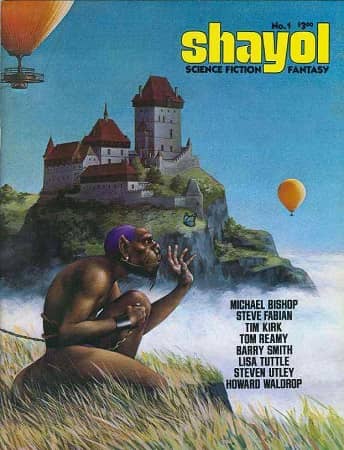 |
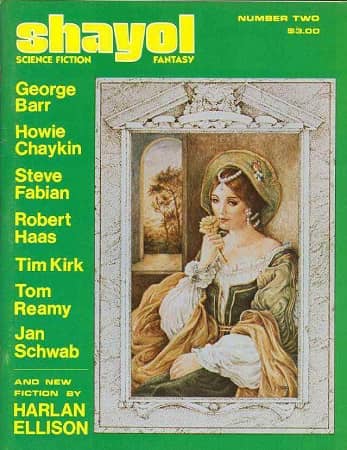 |
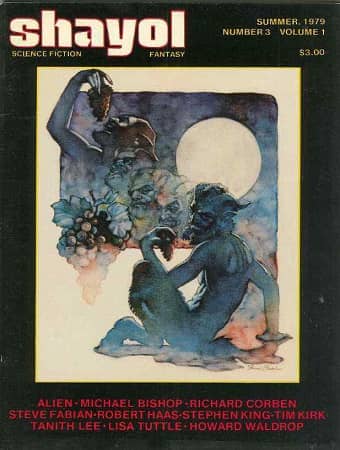 |
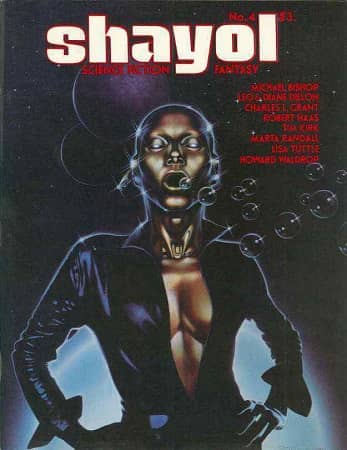 |
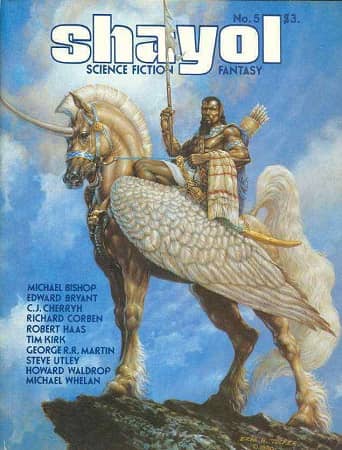 |
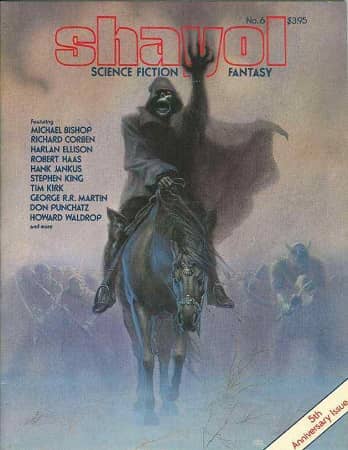 |
Shayol
There were 7 issues of Shayol between 1977 and 1985. It was edited by Pat Cadigan mostly, with some help from Arnie Fenner. It was a successor to the more horror-oriented Chacal, which managed two issues in 1976 and 1977 (the first edited by Byron Roark, the second by Fenner.)
While Shayol remained determinedly semi-professional – it never had very wide distribution, and the editors made a point of thanking the authors for letting them have stories for relatively low rates – it was in my opinion the sharpest-looking of all these magazines. Indeed, it was one of the best-looking SF magazines of all time, based on the two issues I’ve seen, and on reports from other readers. Covers were by Roger Stine, Robert Haas, Thomas Blacksher, Ezra Tucker, Michael Whelan, and Terry Lee. There were hordes of interior illustrations including special portfolios. The layout was very pleasing and professional.
Besides the art features, other non-fiction included editorials, brief bios (and photos) of contributors, book reviews, and occasional articles. But the focus of the magazine was art and fiction.
Regular fiction contributors included Michael Bishop, Howard Waldrop, Lisa Tuttle, Steven Utley, and Harlan Ellison. There were also stories from Tom Reamy, Charles L. Grant, Lewis Shiner, and Cadigan herself. The best of the fiction was by Waldrop, I think, particularly “All About Strange Monsters from the Recent Past” and “’The World as We Know’t’.” The rest of the fiction was mostly pretty sound but – and I know I keep saying this but it is true – not really truly outstanding. (That is I suppose the bane of the semipro magazines: higher paying markets snap up almost all the very best work, though the better semipro magazines certainly publish more interesting middle-range stuff than the middle-range material at the top magazines.)
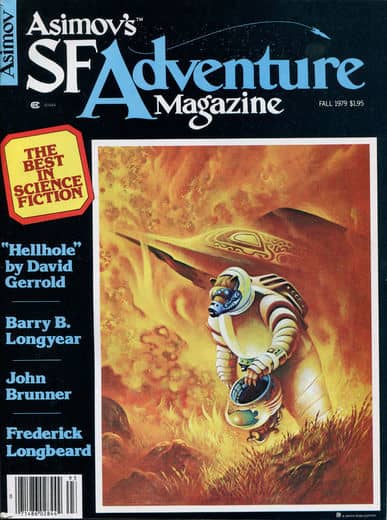 |
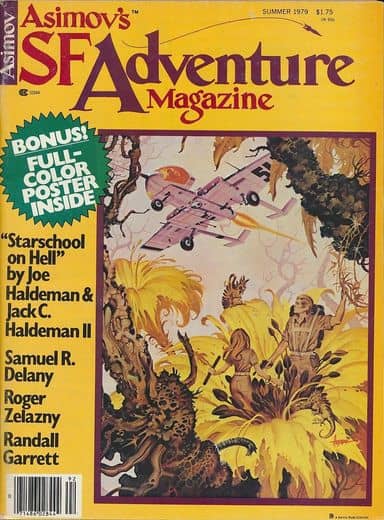 |
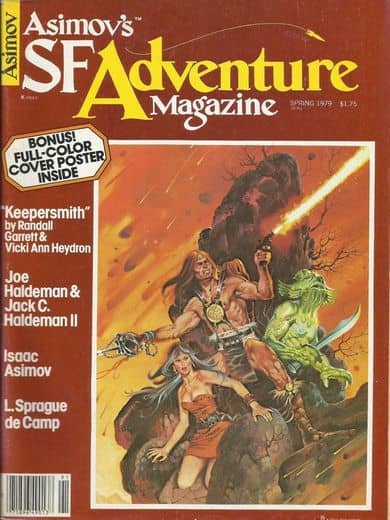 |
Asimov’s SF Adventure Magazine
Finally a magazine of a rather different slant. Asimov’s SF Adventure Magazine was conceived of as a companion to Isaac Asimov’s Science Fiction Magazine (as Asimov’s Science Fiction was then known), with a distinct bias towards adventure-oriented fiction. I believe one hope was to draw more young readers to the field.
There were four issues, one in 1978 and three in 1979. IASFM editor George Scithers was at the helm. The presentation wasn’t terribly impressive: it was large size, but the paper quality was mediocre, and the covers, to my taste, not terribly impressive. (The first three were by Paul Alexander, the last by Stephen Fabian.)
There was a distinct focus on longer stories. The first issue included a complete Stainless Steel Rat novel by Harry Harrison. The other issues each included two novellas. Much of this work was actually quite good. Most significant by far was Samuel R. Delany’s “The Tale of Gorgik,” the first of his Neveryon stories, and rather challenging for that time in having a homosexual hero, and in undercutting many of the expectations attendant on its apparently standard heroic fantasy setup. It’s an excellent story. There was also a Traveller in Black story from John Brunner, a couple of Starschool stories from brothers Joe and Jack C. Haldeman, and, intriguingly, a reprint from the March 1952 Planet Stories: Poul Anderson’s “Captive of the Centaurianess” (in a revised form). A fine Roger Zelazny story, “The Last Defender of Camelot,” also first appeared here.
There were also a couple of Feghoots by “Grendel Briarton” (Reginald Bretnor), and stories by Randall Garrett and Vicki Ann Heydron, Barry Longyear, David Gerrold, and Alan Dean Foster.
Asimov’s SF Adventure Magazine was not apparently a commercial success, and it is not remembered with particular fondness. But it actually published some strikingly good fiction, and it did a pretty good job of adhering to its goal of presenting adventure-oriented material.
Summary
The story of SF in the 70s is not complete without considering these magazines, each a brave attempt at breaking out of the established digest mold of SF ‘zines. Every one was ambitious in one way or another, even if they didn’t always succeed. None of them were very long lived, and truth be told only a few truly lasting classic stories appeared in any of them.
But a lot of undeniably interesting stories appeared here, and they were energetic, fun, and different.
Rich Horton has been a Contributing Editor to Black Gate for over a decade. His last Retro Review for us was a look at the July 1957 issue of Imaginative Tales. His website is Strange at Ecbatan. See all of Rich’s articles here.
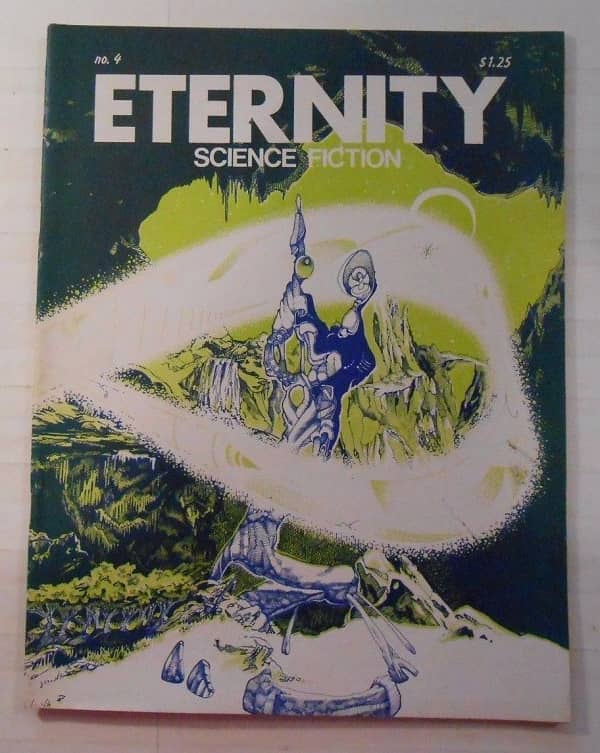
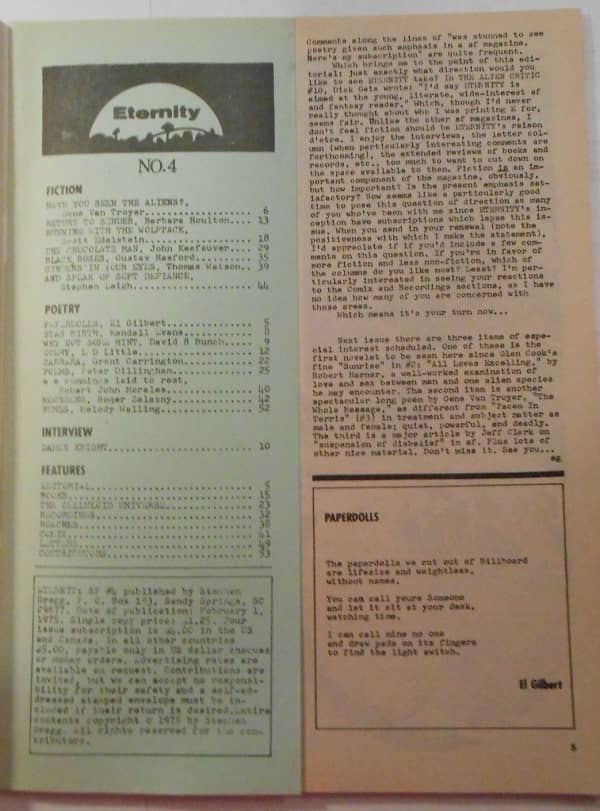
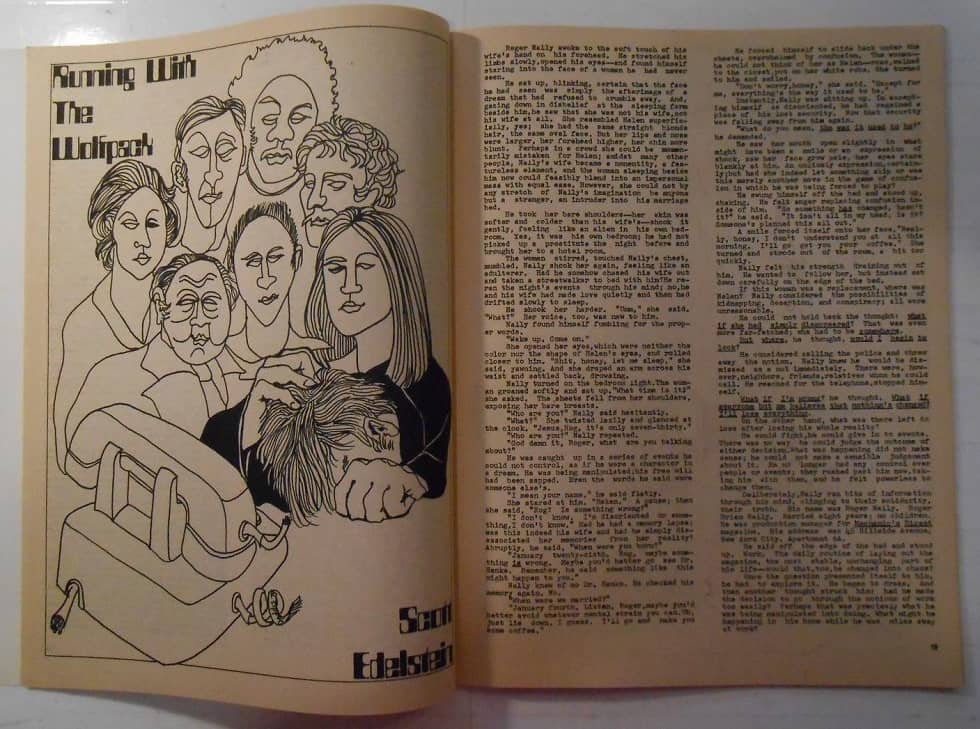
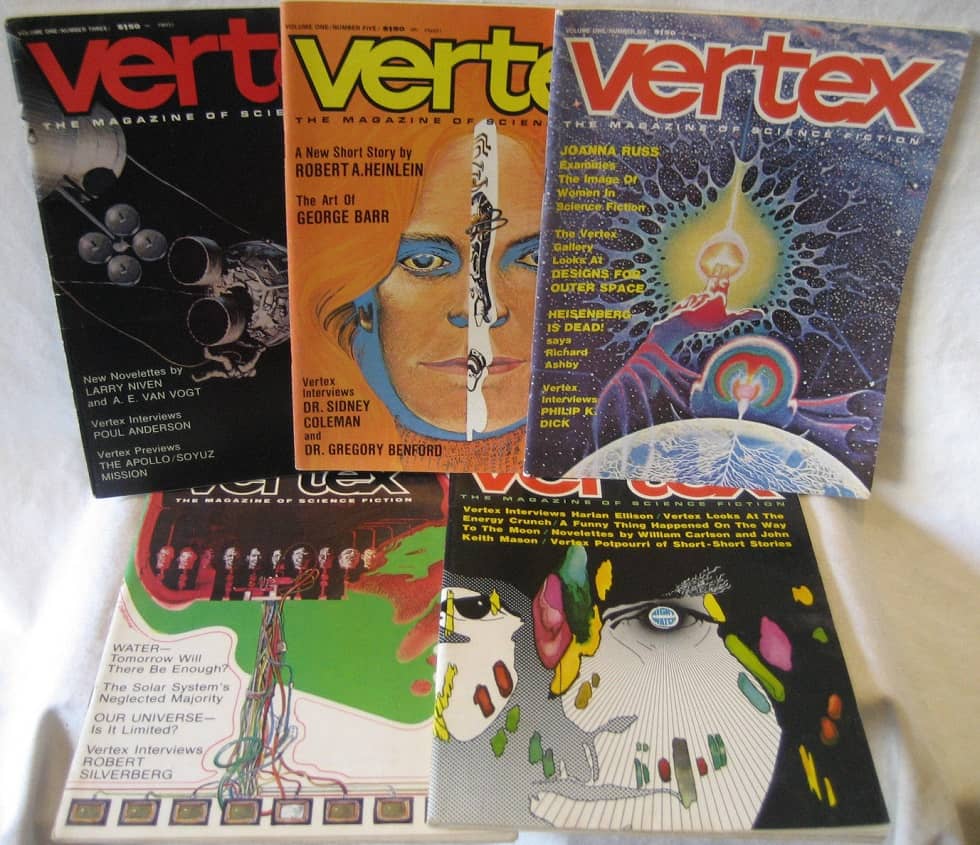
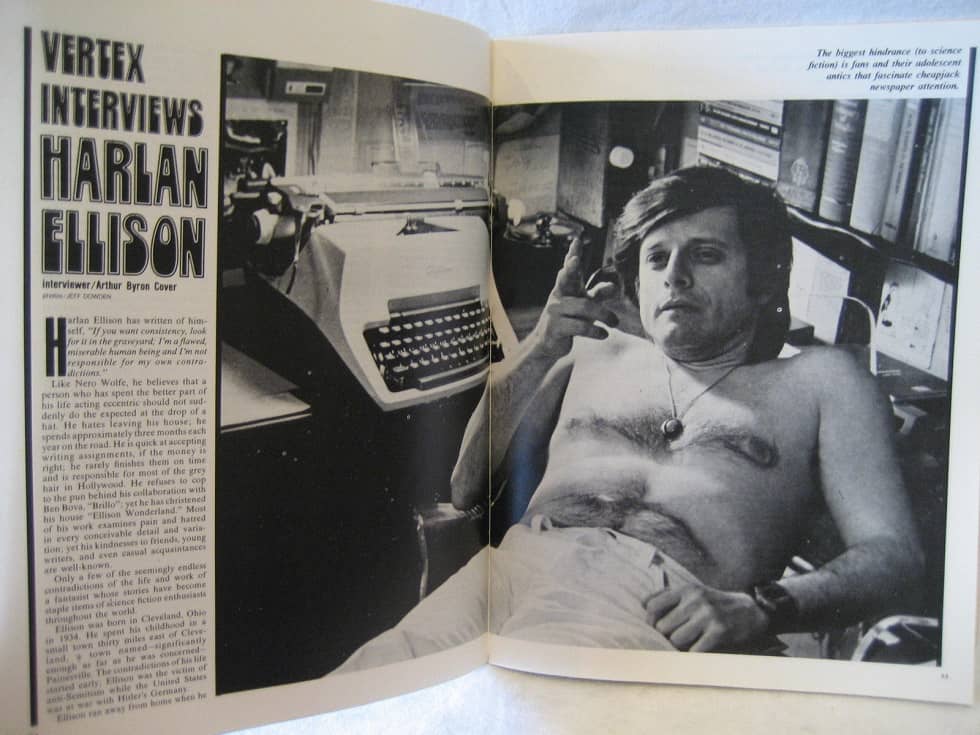
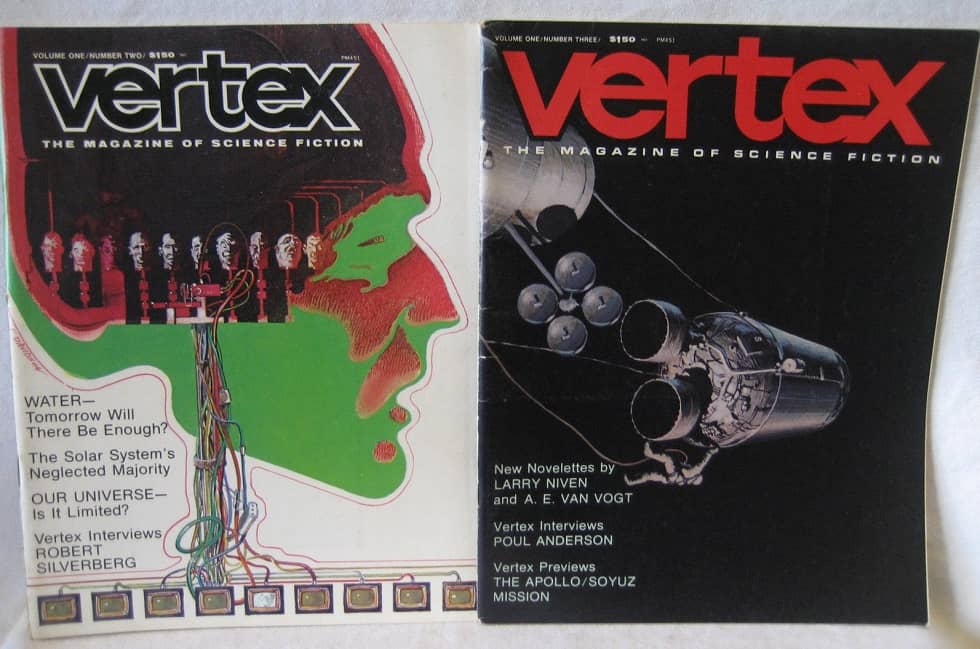
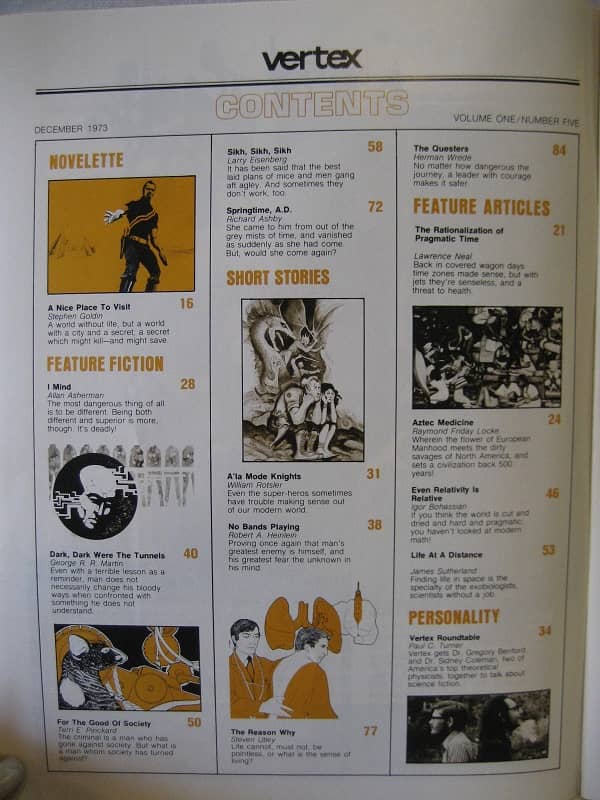
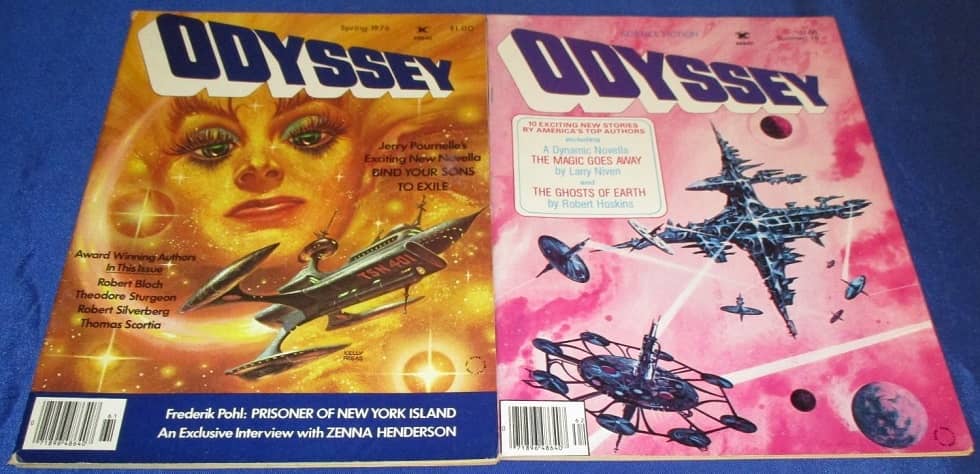
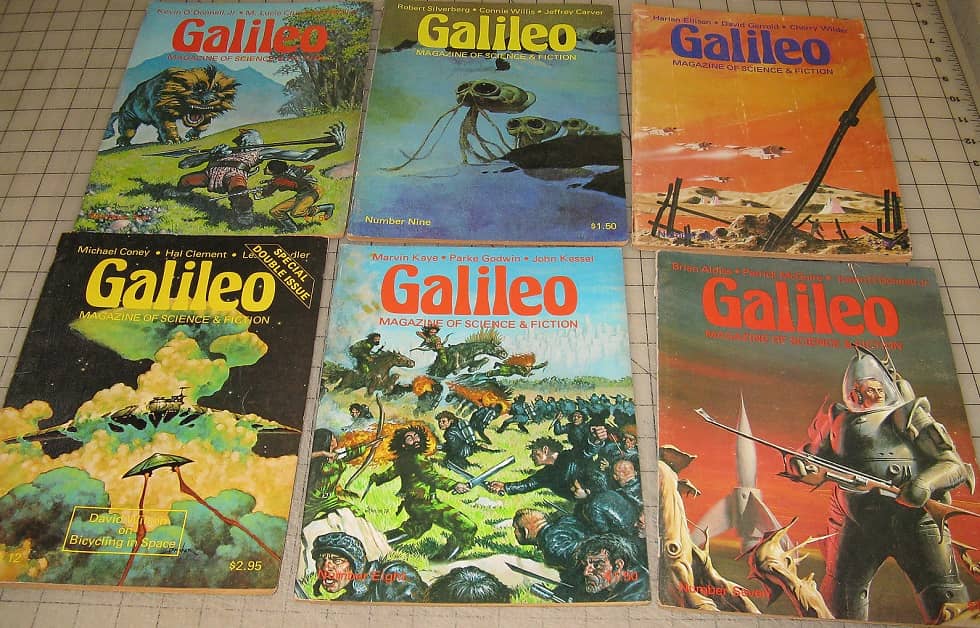
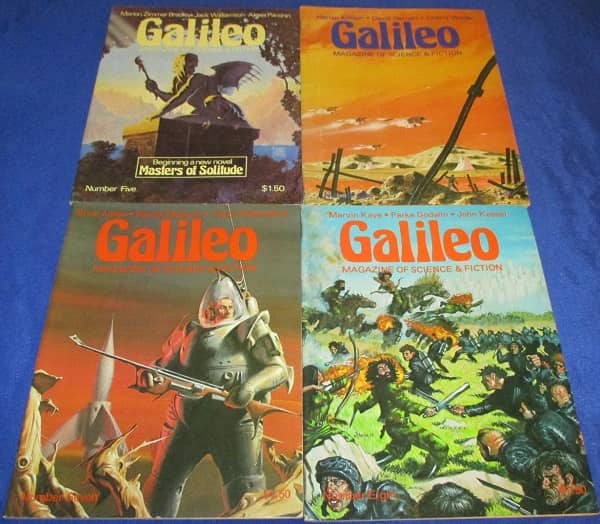
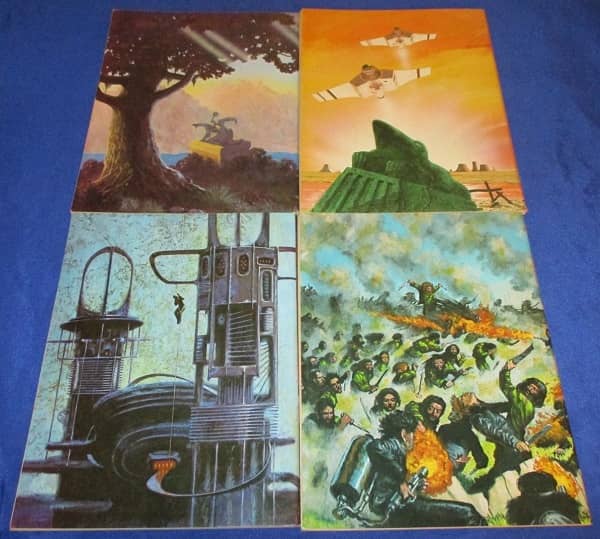
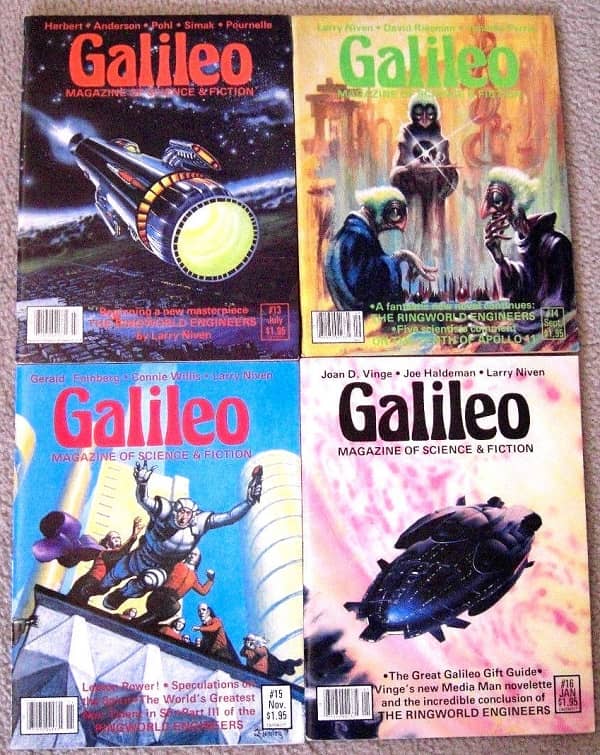
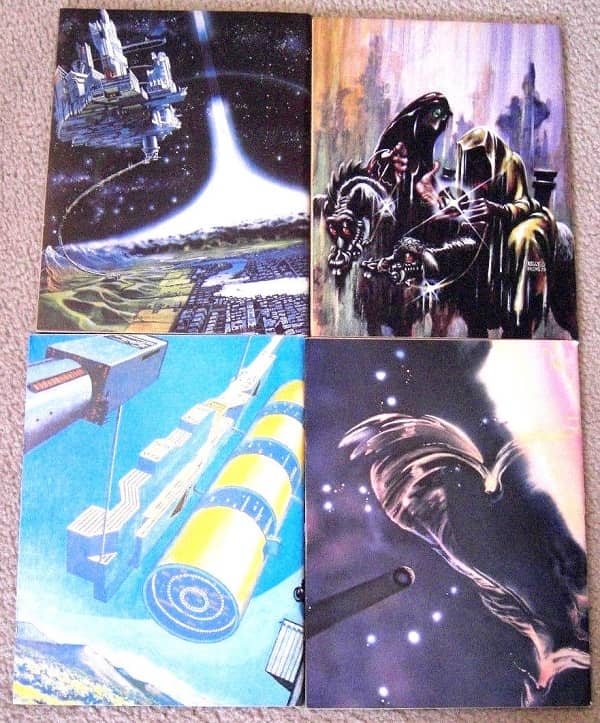
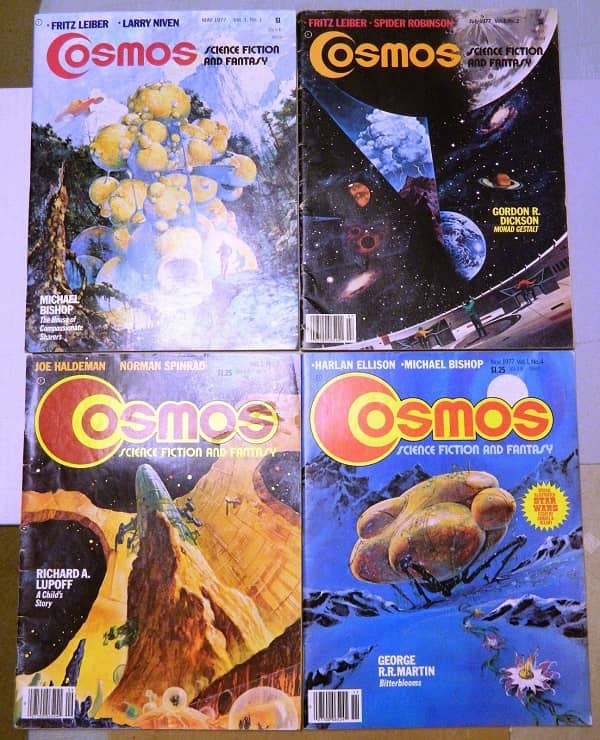
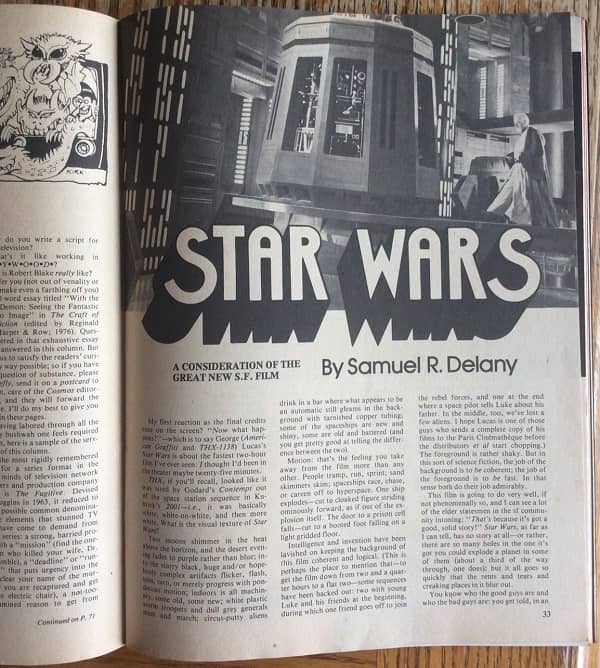
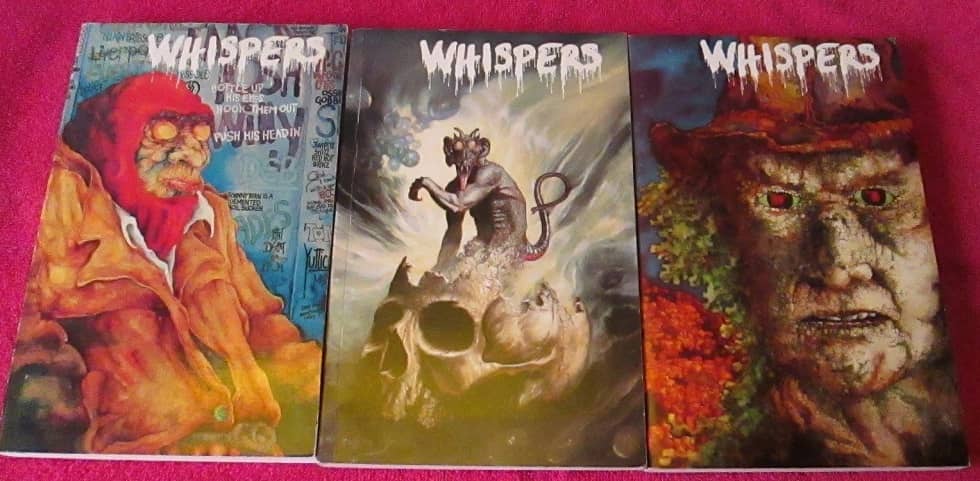
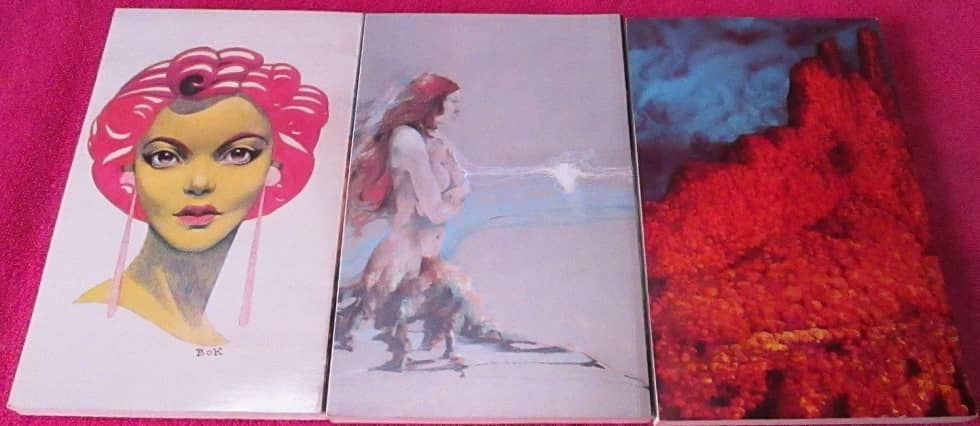
I actually bought one issue of Galileo from a newsstand—which is strange, because I live in South Africa. It was the last one, and I think I still have it.
This is a really terrific piece, Rich. I remember COSMOS, GALILEO, and especially ASIMOV’S SF ADVENTURE MAGAZINE, which I devoured as soon as it was on newsstands. I still remember how disappointed I was when it was canceled after four issues!
Great stuff!
Excellent article, Rich. I read all of these magazines except SHAYOL, which I never saw on the news stand (though I later found two issues at convention dealer’s tables). Bought most of them at an old fashioned news agency in my home town – now long gone, of course – and I have similar memories to yours.
I even share your woeful tale of being ripped off by magazines who failed to honor my subscriptions. I subscribed to GALILEO *right* after buying issue 16 from the news stand. They cashed the check but Charles Ryan never sent me anything. And I did the same with GALAXY, subscribing just after the last digest issue. They actually published a next issue – the only bed sheet sized issue – but they never sent a copy to me although once again, the check was cashed. I had to buy a copy years later from Bob Madle, who’d bought up the publisher’s remaining stock after they folded.
Those were promising days when it seemed as though a new science fiction magazine would turn up on the news stand every year or so. These, along with the smaller magazines like ASIMOV’S, UNEARTH, and those weird little SKY WORLDS reprints made a trip to town for magazines quite an adventure.
Okay so hopefully somebody can help me but I am looking for a story from analog magazine late 70s maybe early 80s about a guy that somehow finds himself on a planet he seems like in the story like he’s a bit of a loser he wanders or is forced into a cave where a creature lands on him or in beds into him and becomes a parasite. The important mantra about the cave is that it results in life and death not life or death or maybe it’s the other way around anyway if the theory is that you’ll either die or you’ll become something even better. Any direction would be wonderful